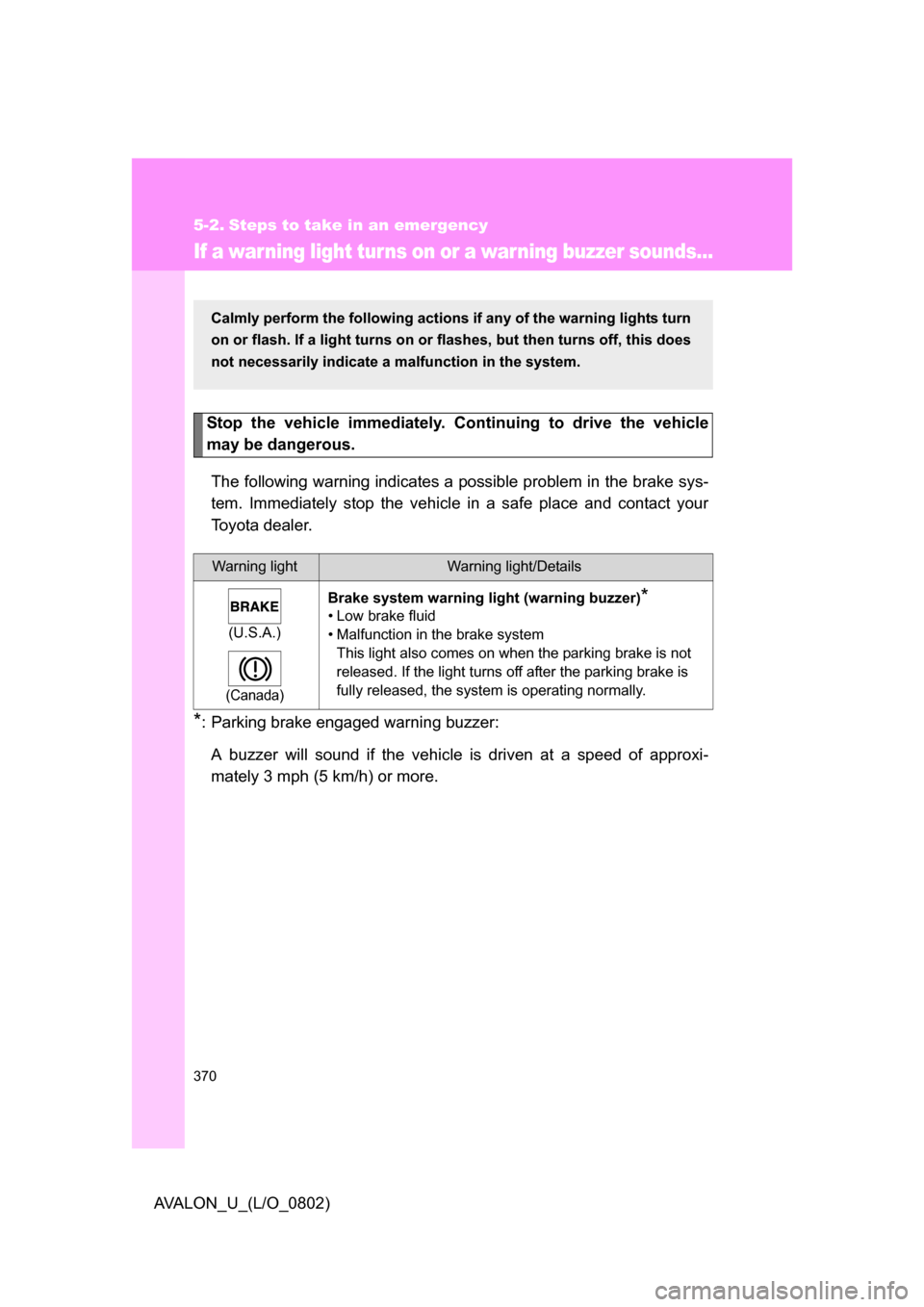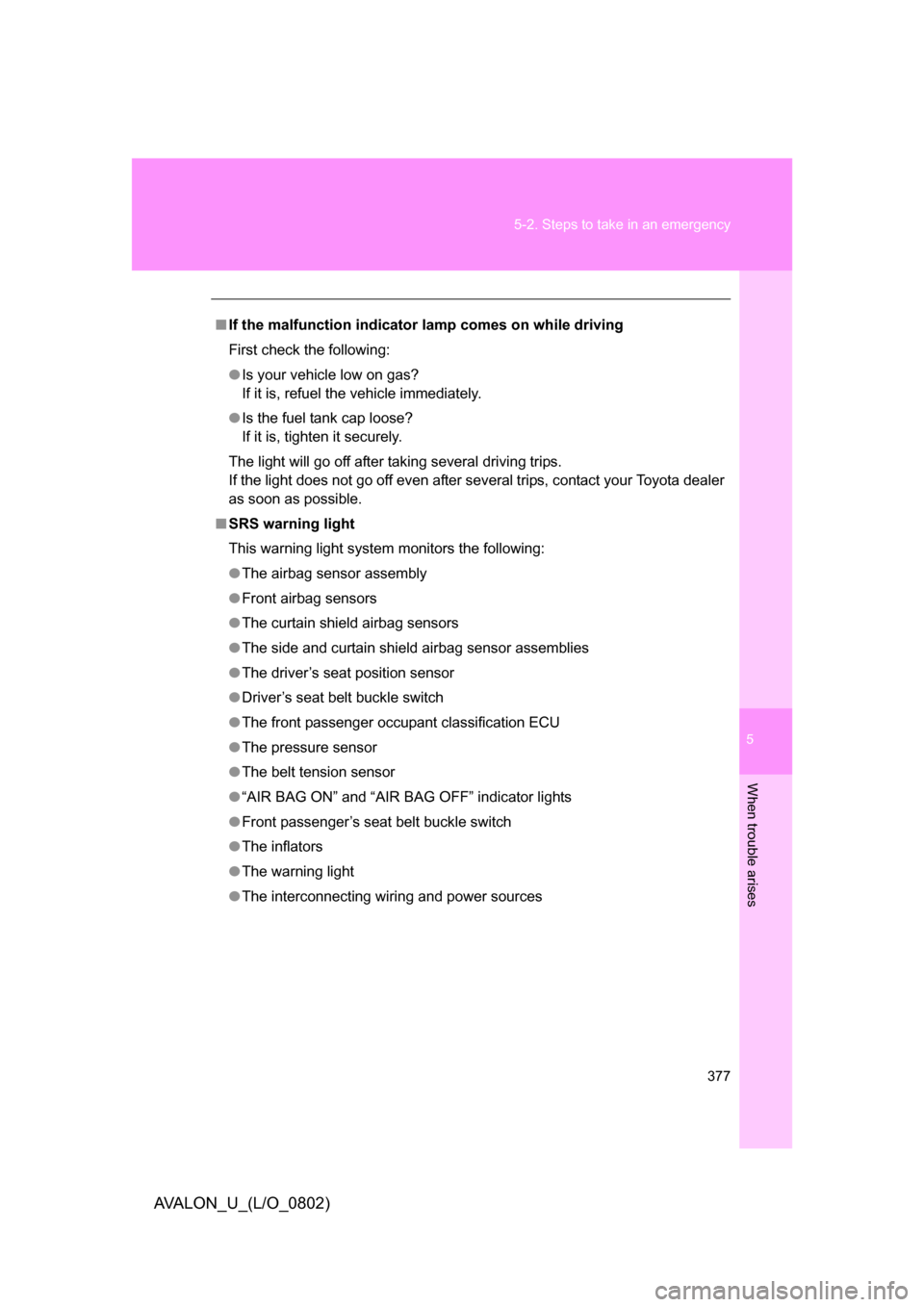Page 358 of 452

358 4-3. Do-it-yourself maintenance
AVALON_U_(L/O_0802)■
Bulbs other than the above
If any of the bulbs listed below has burnt out, have your Toyota
dealer replace it.
● Headlights
● Fog lights
● Front turn signal/parking lights
● Front side marker lights
● Tail lights
● Back-up lights
● High mounted stoplight
■Condensation build-up on the inside of the lens
Contact your Toyota dealer for more information in the following situations.
Temporary condensation build-up on the inside of the headlight lens does
not indicate a malfunction.
● Large drops of water are built up on the inside of the lens.
● Water has built up inside the headlight.
■ LED light bulbs
The high mounted stoplights consist of a number of LEDs. If any of the LEDs
burn out, take your vehicle to your Toyota dealer to have the light replaced.
If two or more LEDs in a stoplight bur n out, your vehicle may not conform to
local laws (SAE).
■ High-intensity discharge (HID) headlights (if equipped)
If voltage to the high-intensity discharge bulbs is insufficient, the light may
not come on, or may go out temporarily. The high-intensity discharge bulbs
will come on when normal power is restored.
Page 359 of 452

4
Maintenance and care
359
4-3. Do-it-yourself maintenance
AVALON_U_(L/O_0802)
CAUTION
■
Replacing light bulbs
● Turn off the headlights. Do not attempt to replace the bulb immediately
after turning off the headlights.
The bulbs become very hot and may cause burns.
● Do not touch the glass portion of the light bulb with bare hands. Hold the
bulb by the plastic or metal portion.
If the bulb is scratched or dropped it may blow out or crack.
● Fully install light bulbs and any parts used to secure them. Failing to do so
may result in heat damage, fire, or water entering the headlight unit. This
may damage the headlights or cause condensation to build up on the lens.
● Do not take apart or repair the low beam discharge headlight bulbs, con-
nectors, power supply circuits, or related components.
Doing so could result in electric shock and death or serious injury.
■ High-intensity discharge (H ID) headlights (if equipped)
● Contact your Toyota dealer before replacing high-intensity discharge
headlights (including light bulbs).
● Do not touch the high-intensity discharge headlight’s high voltage socket
when the headlights are turned on. An extremely high voltage of 20000V
will be discharged and could result in serious injury or death by electric
shock.
■ To prevent damage or fire
Make sure bulbs are fully seated and locked.
Page 370 of 452

370
AVALON_U_(L/O_0802)
5-2. Steps to take in an emergency
If a war ning light tur ns on or a war ning buzzer sounds...
Stop the vehicle immediately. Continuing to drive the vehicle
may be dangerous.The following warning indicates a possible problem in the brake sys-
tem. Immediately stop the vehicle in a safe place and contact your
Toyota dealer.
*: Parking brake engaged warning buzzer:
A buzzer will sound if the vehicle is driven at a speed of approxi-
mately 3 mph (5 km/h) or more.
Warning lightWarning light/Details
(U.S.A.)
(Canada)
Brake system warning light (warning buzzer)*
• Low brake fluid
• Malfunction in the brake systemThis light also comes on when the parking brake is not
released. If the light turns off after the parking brake is
fully released, the system is operating normally.
Calmly perform the following actions if any of the warning lights turn
on or flash. If a light turns on or flashes, but then turns off, this does
not necessarily indicate a malfunction in the system.
Page 377 of 452

5
When trouble arises
377
5-2. Steps to take in an emergency
AVALON_U_(L/O_0802)
■
If the malfunction indicator lamp comes on while driving
First check the following:
● Is your vehicle low on gas?
If it is, refuel the vehicle immediately.
● Is the fuel tank cap loose?
If it is, tighten it securely.
The light will go off after taking several driving trips.
If the light does not go off even after several trips, contact your Toyota dealer
as soon as possible.
■ SRS warning light
This warning light system monitors the following:
● The airbag sensor assembly
● Front airbag sensors
● The curtain shield airbag sensors
● The side and curtain shield airbag sensor assemblies
● The driver’s seat position sensor
● Driver’s seat belt buckle switch
● The front passenger occupant classification ECU
● The pressure sensor
● The belt tension sensor
● “AIR BAG ON” and “AIR BA G OFF” indicator lights
● Front passenger’s seat belt buckle switch
● The inflators
● The warning light
● The interconnecting wiring and power sources
Page 391 of 452
5
When trouble arises
391
5-2. Steps to take in an emergency
AVALON_U_(L/O_0802)
If the engine will not star t
If the engine will not start even though correct starting procedures
are being followed (
P. 122, P. 126), consider each of the following
points.
■ The engine will not start even when the starter motor oper-
ates normally
One of the following may be the cause of the problem.
●There may not be sufficient fuel in the vehicle’s tank.
Add fuel to the vehicle.
● The engine may be flooded.
Try to restart the engine once more following correct starting
procedures. ( P. 122)
● There may be a malfunction in the engine immobilizer system.
( P. 7 5 )
■ The starter motor turns over slowly, the interior lights and
headlights are dim, or the horn does not sound or sounds at
a low volume
One of the following may be the cause of the problem.
●The battery may be discharged. ( P. 397)
● The battery terminal connec tions may be loose or corroded.
Page 392 of 452

392 5-2. Steps to take in an emergency
AVALON_U_(L/O_0802)
Emergency start function (vehicles with smart key system)When the engine does not start, th e following steps can be used as
an interim measure to start the engine if the “ENGINE START STOP”
switch is functioning normally.
Set the parking brake.
Shift the shift lever to “P”.
Set the “ENGINE START STOP” switch to the ACC mode.
Push and hold the “ENGINE START STOP” switch about 15
seconds while depressing the brake pedal firmly.
Even if the engine can be started using the above steps, the system
may be malfunctioning. Have the vehicle checked by your Toyota
dealer.
■ The starter motor does not turn over (vehicles with smart
key system).
The engine starting system may be malfunctioning due to an
electrical problem such as an open circuit or a blown fuse. How-
ever, an interim measure is available to start the engine.
( P. 122)
■ The starter motor does not turn over, the interior lights and
headlights do not turn on, or the horn does not sound
One of the following may be the cause of the problem.
● One or both of the battery terminals may be disconnected.
● The battery may be discharged. ( P. 397)
● There may be a malfunction in the steering lock system (vehi-
cles with smart key system).
Contact your Toyota dealer if the problem cannot be repaired, or if
repair procedures are unknown.
STEP1
STEP2
STEP3
STEP4
Page 398 of 452

398 5-2. Steps to take in an emergency
AVALON_U_(L/O_0802)
■Starting the engine when the battery is discharged
The engine cannot be started by push-starting.
■ To prevent battery discharge
● Turn off the headlights and the audio system while the “ENGINE START
STOP” switch or the engine is turned off.
● Turn off any unnecessary electrical components when the vehicle is run-
ning at a low speed for an extended period, such as in heavy traffic, etc.
■ When the battery is removed or discharged
The following systems must be initialized.
● Power windows (
P. 66)
● Moon roof (
P. 70)
● Tire pressure warning system (
P. 324)
Start the engine of the second vehicle. Increase the engine
speed slightly and maintain at that level for approximately
five minutes to recharge the battery of your vehicle.
Vehicles with smart key system Open and close any of
the doors with the “ENGINE START STOP” switch OFF.
Maintain the engine speed on the second vehicle and turn
the “ENGINE START STOP” switch or the engine switch to
the ON mode, then start the vehicle’s engine.
Once the vehicle’s engine has started, remove the jumper
cables in the exact reverse order in which they were con-
nected.
Once the engine starts, have the vehicle checked at your Toyota
dealer as soon as possible.STEP2
STEP3
STEP4
STEP5
Page 410 of 452
410 6-1. Specifications
AVALON_U_(L/O_0802)
Cooling system
Ignition system
Electrical system
Capacity8.8 qt. (8.3 L, 7.3 lmp.qt.)
Coolant typeUse either of the following:
• “Toyota Super Long Life Coolant”
• Similar high-quality ethylene glycol-based non-
silicate, non-amine, non-nitrite, and non-borate
coolant with long-life hybrid organic acid technol-
ogy
Do not use plain water alone.
Spark plug
Make DENSO
FK20HR11
Gap 0.043 in. (1.1 mm)
NOTICE
■Iridium-tipped spark plugs
Use only iridium-tipped spark plugs. Do not adjust gap when tuning engine.
Battery
Open voltage at
68 F (20 C):
12.6 12.8 V Fully charged
12.2 12.4 V Half charged
11 . 8 12.0 V Discharged
(Voltage is checked 20 minutes after the engine
and all lights are turned off.)
Charging rates 5A max.